#Armadale Castle
Explore tagged Tumblr posts
Text
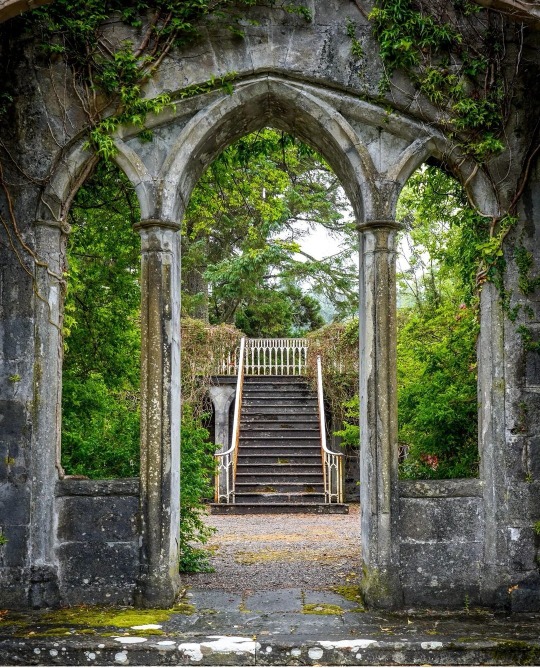
Armadale Castle Gardens / Scotland (by Brede Marthinsen).
#scotland#visit scotland#isle of skye#armadale castle#gardens#uk#wanderlust#travel#placestosee#ecosse#bucketlist
3K notes
·
View notes
Text





9 notes
·
View notes
Text





Once the seat of Clan Donald, Armadale Castle on the Isle of Skye was originally built around 1790 and expanded in the Scottish Baronial style in 1815. After a fire in 1855 and later abandonment in 1925, its ruins now stand among 40 acres of gardens, offering a glimpse into its storied past.
scotland.co
#scotland#scottish#travel#scenery#landscape#nature#travel inspiration#scottish highlands#landscape photography#isle of skye#scottish castle#scottish castles#castle#scotlandtravel#scotland forever
440 notes
·
View notes
Text
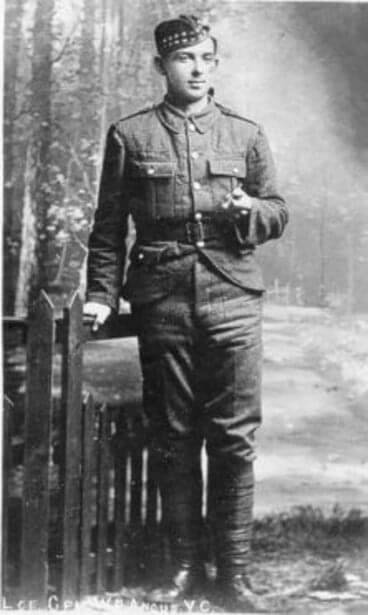

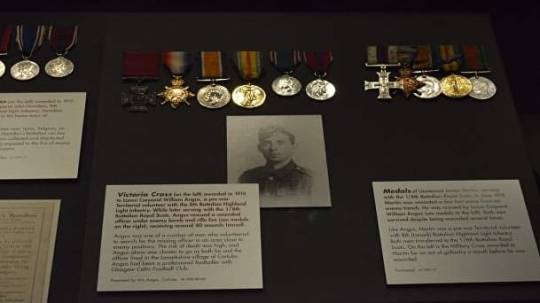
William Angus was born 28th February 1888 at Polkemmet Rows, Cappers, Armadale.
Note some sources say this brave man was born in Carlulke, others give Armadale, he certainly spent a large chunk of his life in South Lanarkshire town. where a commemorative stone was unveiled in his honour in 2015.
On leaving school Angus worked in the nearby coal mines before earning a modest living as a footballer at several clubs, 1914 he was with Wishaw Thistle when war broke out and as a member of local Carluke Territorial battalion of the Highland Light Infantry, he was mobilised immediately.
William Angus was transferred to the 8th Royal Scots, the first Territorial battalion to join the Expeditionary Force. 8th Royal Scots had suffered a great many casualties and were in urgent need of replacements. He was serving as a lance-corporal in this battalion when the following deed took place for which he was awarded the Victoria Cross.
On 12th June 1915 at Givenchy-lès-la-Bassée, France Lance-Corporal Angus voluntarily left his trench to rescue a wounded officer, fellow Carluke man Lieutenant James Martin, who was lying within a few yards of the enemy’s position and had been injured by a mine. To do this he had to travel through 64 metres in no-man’s land under heavy bomb and rifle fire, and received about 40 wounds, some of them being very serious, including the loss of his left eye, losing part of his foot and calf. His commanding officer said there had been no braver deed in the history of the army.
When asked why he had risked death to carry out such a mercy mission, he replied:
“I have to go back to Carluke. I cannot return if I left someone from Carluke to die here.”
40 wounds, can you imagine that?!
Angus was awarded the VC for his bravery in August that year at Buckingham Palace, when the King commented on his 40 injuries, Angus was said to have answered “Aye, sir, but only 13 were serious.”.
Due to his injuries he was no longer fit for active duty and was transferred to Cameronians on recruitment duties and promoted to Sergeant. He was invalided out of the Army in 1917 and started a haulage business, he later became president of Carluke Rovers, where he was known simply as “The VC”., a position he held until his death. Each year of his life, he received a telegram of thanks from the family of the man he rescued.
William Angus VC died just two days after the 44th anniversary of his brave deed. His last annual telegram of thanks from the Martin family was delivered to him in hospital.
William Angus' medals on display at the National War Museum of Scotland, Edinburgh Castle.
You can read a wee bit more detail about William here http://www.vconline.org.uk/william-angus-vc/4585925970.html
23 notes
·
View notes
Text
11.07.23 - Schottland - Richtung Süden
Nach einem guten Abendessen geht heute geht es Richtung Süden. Es ist regnerisch und die Wolken hängen tief. Zwischen Armadale und Mallaig müssen wir dann mit eine Fähre übersetzen. Fahrzeit knapp 1h. ⛴️ Vorher noch ein - endlich mal 😉 - Castle ansehen, aber hier muss man wirklich zugeben, dass es nicht viel typischer geht…inklusive der Wolken. -> Eilean Donan Castle. 🏰








8 notes
·
View notes
Text
Armadale

Armadale is a small town located in the county of West Lothian, Scotland. It’s known for its rich history, including the ruins of Armadale Castle and its picturesque setting surrounded by beautiful countryside.

Armadale Castle

0 notes
Note
If you want to see a bit of lots of different areas, Glasgow is actually a very good base. You can get trains from there down to the Clyde Coast for islands and beaches, up to Loch Lomond, Loch Long and the Gareloch, and through to Edinburgh. And the countryside around Glasgow is beautiful (I'm biased, I live just north of the city).
My recommendations are:
- For a quick and very fun island day, get the train to Largs and the 10 minute ferry to Great Cumbrae. It's only 5 miles long and there's a long standing tradition of cycling round it. You can rent bikes in Millport, which is the only town (you get there by catching a bus from the ferry slip). It's a very quaint pre-Victorian and Victorian town with beaches, ice cream shops, cafes, watersports if you want them, and the scenery is gorgeous.
- Two bigger islands that are still easy to reach are Arran (ferry from Ardrossan) and Bute (ferry from Wemyss Bay), and also Cowal, which is not an island but might as well be (ferry from Gourock).
- To see Loch Lomond, get the train to Balloch or to Arrochar & Tarbet. The latter is a station in between Tarbet on Loch Lomond and Arrochar on Loch Long. All great for a day trip, there are eating places there, and you can catch cruise boats from Tarbet or Balloch. Loch Lomond is absolutely stunning. So is Loch Long. Loch Long is a sea loch (fjord), Loch Lomond is fresh water. The vikings used to bring their boats ashore at Arrochar, portage them to Tarbet and then sail all over Loch Lomond, pillaging as they went. Arrochar and Tarbet are North of the Highland Boundary Fault, so if you want a selfie in the Highlands, there's your chance!
- Edinburgh obviously needs no introduction, there are regular trains between there and Glasgow. July is a very good time to explore it, August is a bit of a nightmare because of the Festival. Take a coat, Edinburgh is cold! If you want to see the Forth Bridges, head to Queensferry. If you're going to the Castle, look up how much it would cost to get a Historic Scotland pass, as Edinburgh Castle is ruinously expensive, and the pass will get you into various other places for free, like Stirling Castle.
- Stirling is one of the old capitals of Scotland and has a marvellous castle and is a lovely wee city to explore, you can reach that by train from Glasgow or Edinburgh.
- Glasgow itself is a beautiful city with lovely Georgian architecture in the centre and Victorian elsewhere. It tends to be wet rather than cold. In particular, the West End, Kelvingrove Park and the Botanic Gardens are excellent to visit. It also has incredible museums which are all free to get into (same in Edinburgh) - Kelvingrove Art Gallery and Museum is a classic. Best way to get to the west end is by Subway, which you'll enjoy as a train fan. It's one of the oldest in the world, and the trains are tiny and very cute. I personally love the Burrell Collection museum, not as convenient, but can be reached by train from Central Station and a walk through Pollok Country Park.
Now, you want a real train adventure, and you want to devote a few days to it, you can take the famous West Highland Line to Mallaig. It's an old line and has not been well maintained, so the trains are slow and it takes about 5 hours, but you will never have more incredible views from a train unless you go through the Rockies or something. The history of the line is also fascinating. It was thought to be impossible to build a railway through this terrain, and it very nearly was - the stretch through Rannoch Moor is floated on brushwood, because the bog is so deep that it swallowed all the ballast they could pour into it, nearly bankrupting the builders. You can book somewhere to stay in Mallaig, which is a reasonable sized town with places to eat and stay, boat trips, and even a short ferry to Armadale on the Isle of Skye. When we stayed there, we went to Armadale one day and explored the castle and gardens, and it was a lovely trip. An alternative to Mallaig is to take the branch line to Oban, which is a pretty, bustling town which acts as the ferry terminal for the Outer Hebrides, and is famous for its seafood.
I will come back to you if I think of any other ideas of things you could do, but these are my best recommendations for the moment. I hope they give you some things to think about!
Hello! You seem to be he right kind of person to ask this.
I’m planning a trip up to Scotland to celebrate finishing secondary school in July for about a week. I was wondering if you have any advice or recommendations for must-see places?
Hello! I would love to do recommendations! And in particular, I can recommend you places that have NOT gone virally popular and are just as good as the ones that have! Viral tourism is a big problem in Scotland, and generally there is something brilliant just down the road from the crowded hotspot that nobody goes to.
Do you have any thoughts already of something you would really like to see? When we went to Japan, we had a list of a few things we really wanted to see and then we built the rest of the trip around that. Don't try and see the whole country in a week, it's bigger than people think.
Also, what sort of transport will you have? Are you planning to hire a car or use public transport?
11 notes
·
View notes
Text


Cannot fault the view though, nature really blows my mind sometimes 🏞🖤
86 notes
·
View notes
Text
Return to Scotland: Part Three
Return to Scotland: Part Three

On the second day of our tour, we were on our way to the Isle of Skye. However, our first stop was the Glenfinnan Viaduct. For all you Harry Potterlovers out there, the Glenfinnan Viaduct is the location where the Hogwarts Express passes through in the films. The viaduct’s primary purpose however is to serve as a bridge which services a railway that passes through it. For some of my tour mates,…
View On WordPress
#Armadale Castle#explore#Glenfinnan Viaduct#Harry Potter#Hogwarts Express#Isle of Skye#Portree#Scotland#Travel#Wanderess
0 notes
Photo

Cryptid of the Day: Armadale Castle Sea Serpent
Description: During a voyage, the Armadale Castle struck a large fish, estimated to be 57ft long and 8ft in diameter by Captain JC Robinson. The crew argued its species, with some saying it was a whale while others claim it was a sea serpent, called “Piscis Rudyardensis”.
41 notes
·
View notes
Text
Let’s talk about tartan.
so the thing is. the thing is, “tartan is stylish” was, from roughly the Victorian era to the Edwardian era, very true. it became very fashionable, especially amongst Londoners, and as I like to think that most of Aziraphale’s interests date to around this period since that’s the century Crowley slept through in the book, that was just a little detail that made me quite happy. but.
the reason that tartan became fashionable at this point was a cultural shift from perceiving Highlanders and their culture as threats to be systemically eliminated (tartan had been outlawed in 1746 for this very reason), to people whose culture was seen as an interesting commodity, largely instigated by George IV’s visit to Edinburgh where he encouraged Highland leaders to wear their tartans. most clan tartans also date to around this time- usually made for expats with Scottish heritage or those in Scotland who had lost touch with their own culture due to oppressive laws, only to end up buying into a mocked-up version of it in an attempt to restore ‘highland spirit’.
so I was sat there with all my information about Aziraphale committing ye olde cultural appropriation, and didn't really have much of an opinion about it other than. it’s quite interesting until a friend of mine pointed out that this is peak Aziraphale in terms of wilful ignorance & privilege- he is able to ignore the history and have tartan just be a pretty pattern, and likewise he is able to believe in heaven’s party line and completely ignore any evidence (especially in the form of Crowley) that might make him think, even for a second, that his ideology is wrong because it’s so much easier to just go along with it, and he has the luxury of doing so.
and then if we continue with this dodgy extended metaphor what gets REALLY interesting is heaven’s war uniform having tartan- you remember I said tartan was banned in 1746? the exception to that was in the army. full regiments of highlanders were recruited, often driven by unemployment, for the 7 years war against France, because it kept them under the control of a watchful officer and they made excellent cannon fodder. you would reclaim the badge of your culture only to die in it. we can draw a parallel to the tartan disappearing off Aziraphale’s clothing when he's discorporated- we can also draw a strong parallel between heaven and colonialist Britain at this time period, with its desire for disposable foot soldiers and a clear feeling of inherent ideological supremacy. the need for war and the need to conquer.
#good omens#aziraphale#meta#I know its not meant to be that deep but neilman was in Skye this summer and you know what else is is Skye??#the Armadale castle museum which explains all of this in excruciating detail#tartan is stylish#collonialsim
15 notes
·
View notes
Text
Laird Hasenbär in Schottland - Tag 11 Teil 1
Lairds and Ladies!
Unser erster Besichtigungspunkt heute Vormittag ist das Armadale Castle, ehemaliger Sitz des Clan MacDonalds mit schöner Gartenanlage.

Satz mit X: war wohl nix!
Leider ist das Castle wegen andauernder Renovierungsarbeiten für das Jahr 2022 komplett geschlossen. Eine Wiedereröffnung für das Publikum ist für 2023 anvisiert.
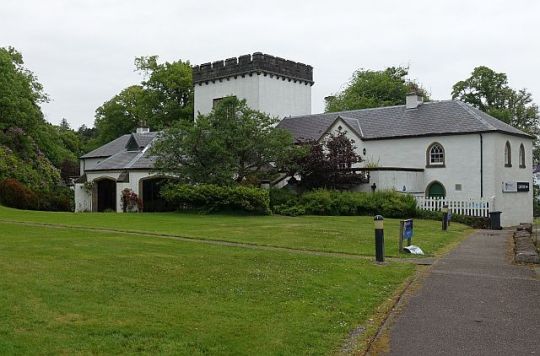
Der Ursprung des Anwesens war ein Haus, das 1790 erbaut wurde. Damals zog die Familie des Clan-Chiefs von Monkstadt auf der nördlichen Halbinsel Trotternish auf die südliche Halbinsel Sleat um und baute das Anwesen bei Armadale bis 1815 weiter aus. Federführend war der Architekt James Gillespie Graham, der zum Beispiel auch das Glenfinnan Monument entwarf. Er gab Armadale den damals typischen Look im Scottish Baronial Style.
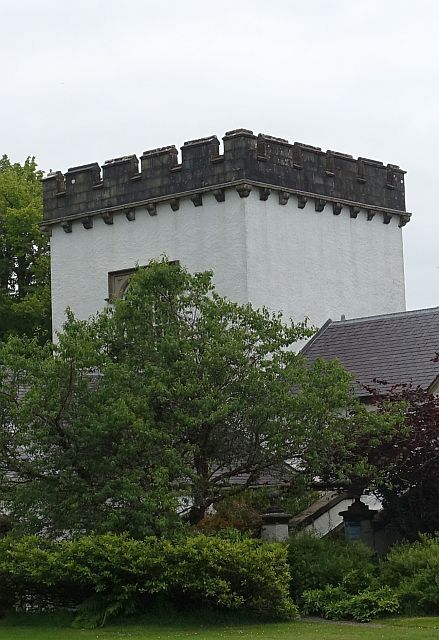
Clan Donald war einst die wichtigste Sippe der Highlands und Islands. Doch dann kamen die Highland Clearances, deren Auswirkungen auch die MacDonalds in alle Himmelsrichtungen der Erde verstreute. Als 1971 der MacDonald-Chief die letzten Clan-Ländereien auf der Isle of Skye zum Verkauf anbot, handelten die Mitglieder: Sie legten Geld in einer Stiftung zusammen und kauften die Armadale Castle sowie das umliegende Land auf. So schufen sie hier die letzte Heimat der MacDonalds, die das Clan-Erbe bewahren soll.

Die Gärten allerdings sind geöffnet und können gegen Gebühr besichtigt werden. Als wir jedoch gerade am Castle ankamen und den Wagen parkten, fing es natürlich wieder an zu regnen. Das war ja mal wieder klar! Also beließen wir es bei ein paar Schnappschüssen und stiegen wieder ins Auto ...

Knapp 7 Kilometer weiter erreichen wir die Torabhaig Brennerei. Dort hatten wir eine Führung für 14 Uhr vereinbart und bereits vor einigen Wochen von zu Hause aus reserviert.
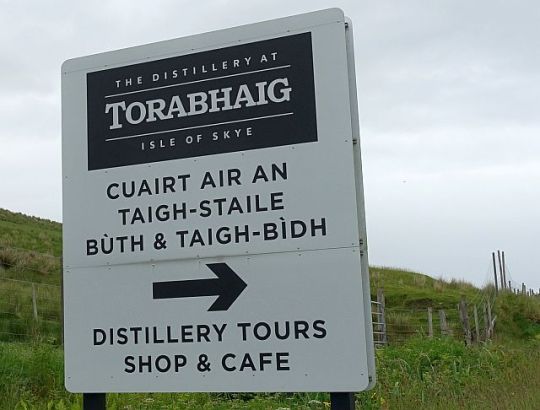
Die Führungen bei Torabhaig findet in sehr kleinem Rahmen statt. Maximale Größe der Gruppen ist 8 Personen. Eine Reservierung vorab ist dringend angeraten, da walk-in-Besucher unter Umständen lange warten müssen oder mit ganz viel Pech gar keine Besichtigung unternehmen können.

Der Excise Act von 1823 sanktionierte erstmals vor fast 200 Jahren das legale Destillieren von Whisky in Schottland, kurz darauf wurde die erste Lizenz auf Skye erteilt.
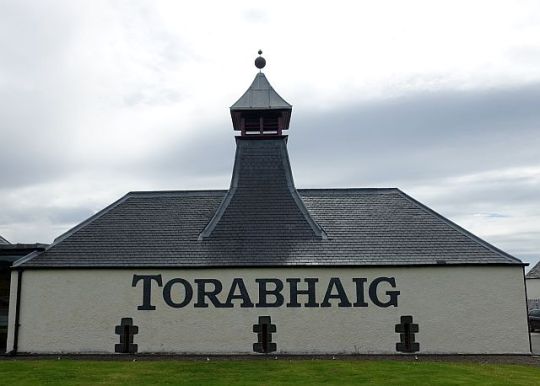
Bis 2017 war Talisker tatsächlich die einzige Single Malt Whisky Brennerei auf Skye. Der anhaltende Whisky-Boom ermutigt Schottlands Whisky-Industrie nach wie vor zur Planung und Bau neuer Brennerei-Projekte. Natürlich rüsten auch die schottischen Inseln fleißig auf. Und so war es nur eine Frage der Zeit bis die meist besuchte Insel Schottlands Verstärkung in Sachen Whisky bekam.
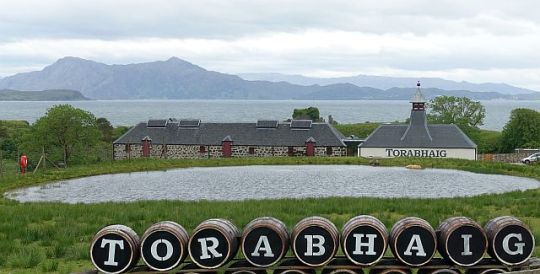
Die Location ist atemberaubend schön und sicherlich nicht zufällig gewählt. Torabhaig ist an der Süd-Ost-Küste der Insel positioniert und somit ideal für Besucher gelegen, die die Brennerei auf ihrem Weg passieren.
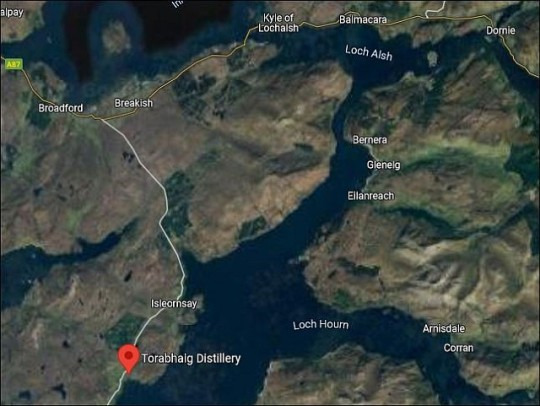
Nimmt man die Fähre von Mallaig nach Skye kommt man unweigerlich an Torabhaig vorbei. Auch von der Skye Bridge ist es keine halbe Stunde mit dem Auto. Die Distillerie mit ihren weiß getünchten Außenmauern blickt direkt aufs Meer.
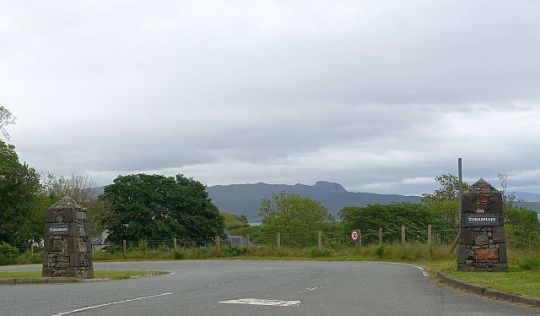
Der eigentliche Gründer der Brennerei war Sir Iain Noble. Der ehemalige Bänker engagierte sich sehr für den Erhalt der gälischen Sprache und Kultur. 1976 gründete er den unabhängigen Abfüller Pràban na Linne (Gälische Whiskys), die beispielsweise die Blended Whiskys Mac Na Mara und Té Bheag produzieren.

Unglücklicherweise starb Sir Iain Noble im Jahr 2010, bevor er seinen Traum einer eigenen Whisky-Brennerei verwirklichen konnte. Er hatte jedoch noch vor seinem Tod die Erlaubnis für den Bau der Brennerei erhalten. Der niederländische Konzern Marussia Beverages hatte zeitgleich geplant eine Brennerei auf der Insel zu bauen und setze daher die Arbeit von Sir Noble fort.
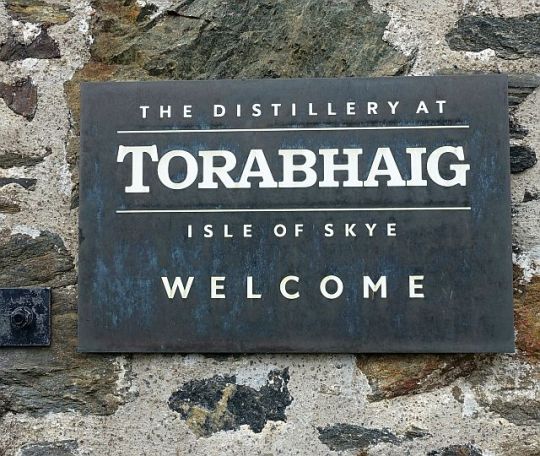
Mit den neu gegründeten Mossburn Distillers übernahm das Unternehmen den Bau und die Fertigstellung der Brennerei. Nach vier Jahren Renovierungsarbeiten konnten die alten Farm-Ruinen auf dem Gelände in moderne Brennerei-Gebäude umgewandelt werden.
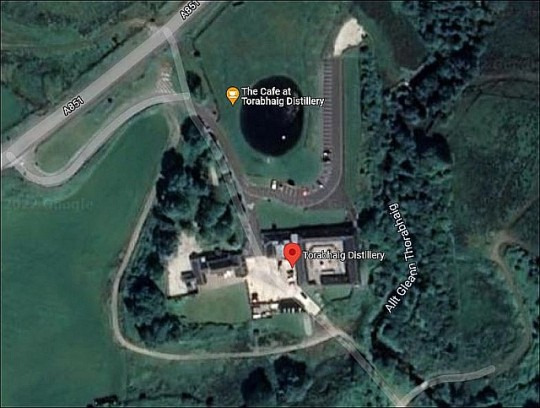
Vor ungefähr 200 Jahren wurden die Steine, aus dem dieses Gebäude besteht, mit Pferd und Wagen aus der Burgruine in der Bucht heraufgeholt. Männer schufteten von morgens bis abends, um diese Farmgebäude zu errichten, das die nächsten Jahre überdauern sollte, bis sich die landwirtschaftlichen Praktiken änderten.

Die Gebäude wurden vollständig restauriert, um die neuen Kupferstills und traditionellen hölzernen Washbacks zu beherbergen. Es wurde sogar ein Dach konstruiert, das entfernt werden kann, um die Destillierapparate auswechseln zu können, ohne das renovierte Gebäude wieder zu zerstören. Das ist bei den neueren Brennereien oftmals so entworfen.
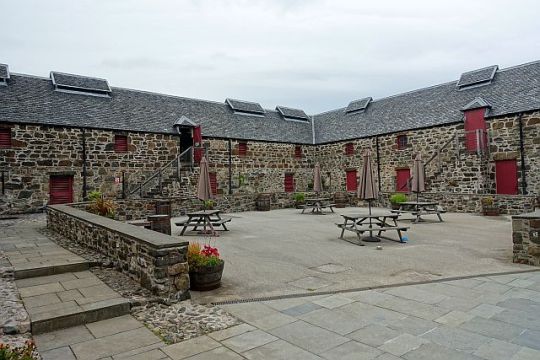
Die Gebäude sind in einem Viereck angelegt mit einem großen Innenhof, für Farmanlagen keine unübliche Konstellation. Bei der Restauration hat man wirklich ganze Arbeit geleistet.
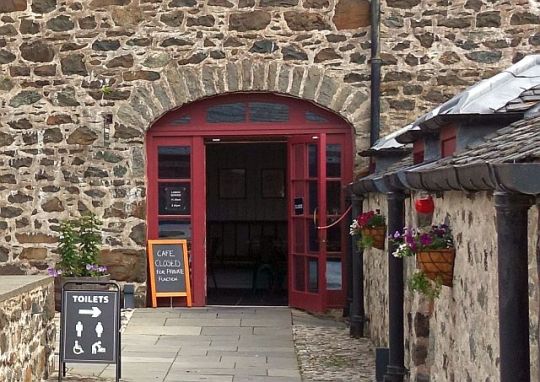
Die Brennerei ist natürlich mit einem Cafe ausgestattet: eine traumhafte Location für einen Afternoon Tea mit Scones! Leider war dies wegen einer privaten Feier an unserem Besuchstag nicht möglich.

Das Besucherzentrum ist schlicht und elegant eingerichtet. Es bietet eine Reihe schöner Whisky-Souvenirs, natürlich die eigenen Whisky Marken Mossburn und Torabhaig, sowie Produkte aus Harris Tweed.

Torabhaig geht den klassischen Weg der Malt Whisky Produktion in Schottland. Das Malz mit dem Rauchgehalt wird in einer stählernen Mashtun mit Kupferdeckel zur Stammwürze ausgewaschen.
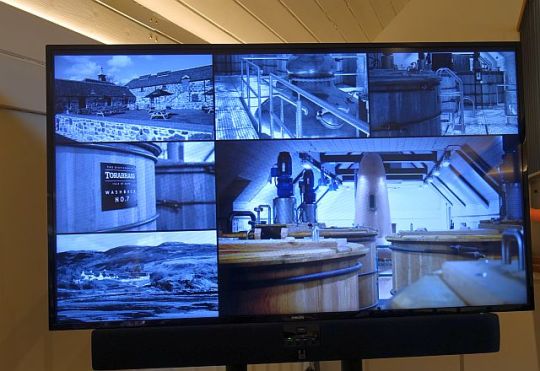
Die acht hölzernen Washbacks bestehen aus Douglas-Fichte und halten die Würze rund 72 Stunden zur Vergärung. Anschließend wird auf den beiden klassischen Kupferbrennblasen aus der schottischen Kupferschmiede Forsyths gebrannt.
Die Angaben zur Kapazität der Brennblasen auf der Tour widersprechen allerdings denen auf der Website.

Was uns allerdings neben dem Foto-Verbot des Produktionsprozesses gestört hat, ist die Tatsache, dass die Brennerei gar keine Lagerhäuser vor Ort hat. Aus welchem Grund Mossburn Distillers sich entschieden haben, keine Lagerhäuser auf Skye zu bauen, hat sich uns nicht erschlossen.

In jedem Fall schießt sich die Brennerei hier ins eigene Knie, denn da büßt der spätere „Insel-Whisky“ von Torabhaig massiv an Glaubwürdigkeit ein, da er, für jeden Besucher ersichtlich, schlichtweg gar nicht auf der Insel reift. Die überall in Szene gesetzten Fässer sind nur Dekoration.

Zwar ist es, besonders bei größeren Brennereien, gängige Praxis nicht den gesamten Whisky vor Ort zu lagern, dass sich aber eine Brennerei gänzlich gegen die Reifung für Ort entscheidet, ist schon ziemlich eigenartig.
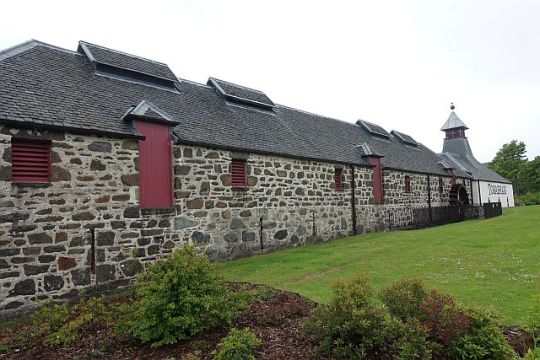
Die Tour startet in dem Souvenir-Shop, vor der Treppe zu der eigentlichen Produktionsstätte. Dauer ist zwischen 45 und 60 Minuten.

Kostenpunkt pro Person 10 £ , wovon 5 Euro als Gutschein bei einem späteren Kauf verrechnet werden.
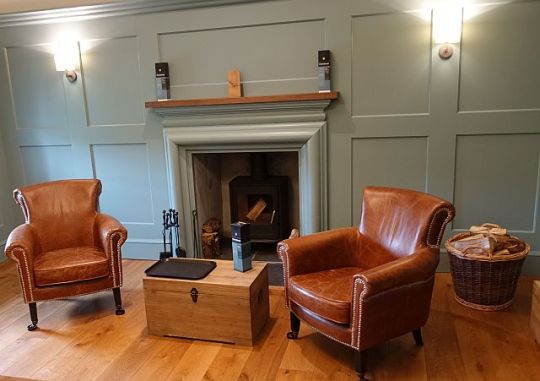
Das ist nicht teuer, zumal es im Tastingroom ja auch noch eine Probe zur Verkostung gibt.
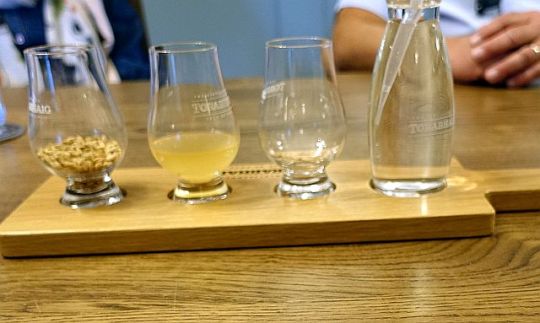
Die Tour ist gut, aber noch ausbaufähig. Bei dem Preis macht man aber nichts verkehrt und die kleinen Gruppen sind sehr angenehm.

Das Wetter will einfach nicht besser werden - jetzt zieht auch noch Sturm auf ...

Wir machen uns auf den Weg in Richtung Cottage und stoppen noch einmal auf halben Weg.

Fährt man über die A 87 von der Isle of Skye oder auf die Insel, dann kommt man unweigerlich an einer malerischen Straßenkreuzung mit einer Bilderbuchbr��cke vorbei: der Sligachan Bridge.

Sligachan wird in etwa „Schligachen“ ausgesprochen und bedeutet so viel wie „Platz der kleinen Muscheln“. Im nahen Loch gab es wohl viele davon.

Die pittoreske Steinbrücke über den Sligachan River gibt mit den schroffen Bergen im Hintergrund ein ganz hervorragendes Foto-Motiv ab. Alleine dafür lohnt sich ein Halt.
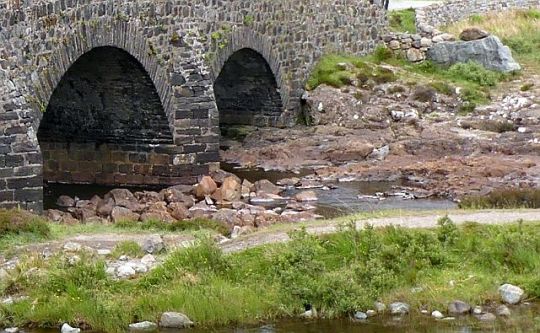
Die Sligachan Old Bridge wurde zwischen 1810 und 1818 von Ingenieur Thomas Telford gebaut.
Die Steinbrücke besteht aus drei Bögen, die jedoch ungleich groß sind. Die Brücke ist einspurig und hat einen für die Zeit charakteristischen Buckel über dem Mittelbogen.
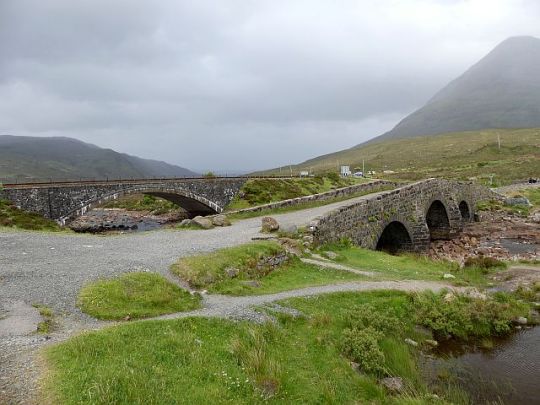
Die Brücke ist nur noch für Fußgänger und Radfahrer zugänglich, nachdem parallel dazu eine neue Straßenbrücke auf der A87 gebaut wurde.
Das erste Gasthaus an dieser Stelle soll bereits um 1700 herum entstanden sein. Das “neue” Hotel wurde im Jahre 1830 gebaut und dient seitdem als Ausgangspunkt für Wanderer.

Und natürlich – wir sind ja schließlich in Schottland – hat Sligachan auch eine zünftige Feengeschichte zu bieten.
Diese Geschichte beginnt mit Scáthach, der wildesten Kriegerin Schottlands. Es wird angenommen, dass sie in Dunscaith Castle lebte, das sich in Tokavaig im Süden der Insel befindet. Scáthach war stark und konnte jeden Mann im Kampf schlagen. Bald verbreiteten sich Gerüchte über ihre Stärke und es war nur eine Frage der Zeit, bis sie von der berühmten irischen Kriegerin Cú Chulainn herausgefordert wurde.
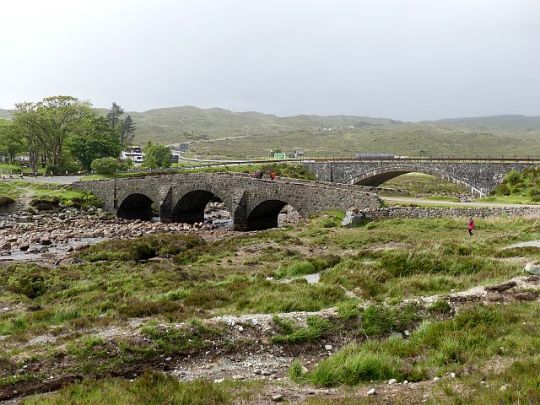
Entschlossen, seine Stärke zu beweisen, segelte er nach Skye, um Scáthach zu besiegen. Nach seiner Ankunft traf er eine von Scáthachs Töchtern und forderte sie auf, ihre Mutter zum Kampf mitzubringen. Er zielte darauf ab, Scáthach zu vernichten und allen Zweiflern seine Stärke zu beweisen.
Obwohl Cú Chulainn ein halber Gott mit der Stärke von tausend Elefanten ausgestattet war, war das Paar ebenbürtig und wochenlang tobte ein erbitterter Kampf. Die beiden Krieger waren so stark, dass ihre vernichtenden Schläge die ganze Landschaft veränderten. Die Erde bebte, als Täler und Berge entstanden.

Es schien, als würde der Kampf nie enden und es wurde schnell klar, dass es nur einen Weg gab, dieses Verfahren zu beenden: einen Kampf auf Leben und Tod. Scáthachs Tochter war verzweifelt und sah keine Möglichkeit, dass ihre Mutter den Kampf gewinnen könnte. Sie floh und rannte zum Fluss Sligachan. Hier entleerte sie sich der Tränen, während sie darum bat, die Kämpfe zu beenden.
Ohne ihr Wissen fungiert das Wasser als Tor zwischen unserer Welt und der Feenwelt. Ihre Schreie waren so bitter, dass das Geräusch durch das Portal drang und die magischen Wesen beschlossen, ihr zu helfen. Sie befahlen der Tochter, ihren Kopf sieben Sekunden lang unter die Wasseroberfläche zu tauchen, um ihr mitzuteilen, wie sie die Gewalt beenden könnte. Sie tat, was von ihr verlangt wurde, und tauchte erleuchtet aus dem Fluss auf.

Da sie wusste, dass die Zeit drängte, sprintete die Tochter um die Insel herum und sammelte alles, von Nüssen bis hin zu Kräutern. Als sie nach Hause zurückkehrte, kochte sie alles, was sie gesammelt hatte, in einer herzhaften Brühe. Als der Duft des Essens in die Luft stieg, fächerte die Tochter den Rauch auf, weil sie wusste, dass der Wind ihn einfangen würde.
Das köstliche Essen in der Ferne riechend, kämpften die Krieger weiter, bis ihr Hunger unerträglich wurde. Es war Wochen her, seit sie gegessen hatten. Die Krieger erklärten sich bereit, eine Pause vom Kampf für eine Essenspause einzulegen, und machten sich auf den Weg zu Scáthachs Haus.
Nachdem sie von der Tochter begrüßt worden waren, feierten beide Krieger zusammen. Es war diese Mahlzeit, die das Ende der Kämpfe markieren würde, so wie es die Feen vorhergesagt hatten. Durch das Essen in Scáthachs Haus war Cú Chulainn zu einem Gast geworden, und daher konnte keiner der Krieger den anderen mehr verletzen. Der Kampf war vorbei.
Die Legende besagt, dass die Schönheit von Scáthachs Tochter und die Tränen, die sie im Fluss vergoss, bedeuten, dass jedem, der mutig genug ist, sein Gesicht ins Wasser zu tauchen, von den Feen ewige Schönheit verliehen wird. Die Suche nach ewiger Schönheit an der Sligachan Bridge ist zwar nicht gerade angenehm, aber bei weitem nicht so strafend, wie Dorian Gray!
Und hier kommt die Gebrauchsanweisung dazu: man muss das Gesicht mindestens 7 Sekunden lang in den Fluss tauchen und tatsächlich auch vollständig eintauchen. Dazu muss man wirklich runter auf die Knie. Wie zu erwarten, ist das Wasser absolut eiskalt.

Danach darf man sich auch nicht das Gesicht abtrocknen, sonst funktioniert die Feenmagie nicht! Damit die ewige Schönheit greift, muss man abwarten, bis das Gesicht auf natürliche Weise getrocknet ist.
Mich beschleicht allerdings der Verdacht, die Einheimischen haben sich diese Story zu ihrer eigenen Belustigung ausgedacht, um die Touristen dort würdelos herumrutschen zu sehen. Trotzdem hat ein bisschen Magie noch niemandem geschadet, oder? Ich gehe aber sicherheitshalber weiter zur Kosmetik...
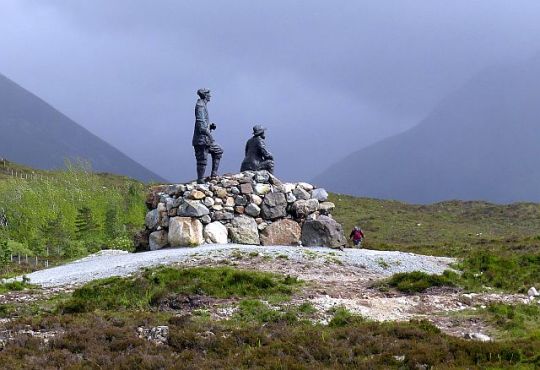
Unweit der Brücke befindet sich seit September 2020 eine vom lokalen Künstler Stephen Tinney geschaffene Bronzeskulptur. Sie zeigt den in Sconser geborenen Kleinbauern John Mackenzie sitzend und Professor Norman Collie stehend.

Mackenzie – der erste britische professionelle Bergführer alpinen Standards – bildete mit seinem großartigen Freund Collie eine fruchtbare Kletterpartnerschaft, die 50 Jahre andauerte, während der sie viele der Cuillin-Gipfel kartierten und benannten.
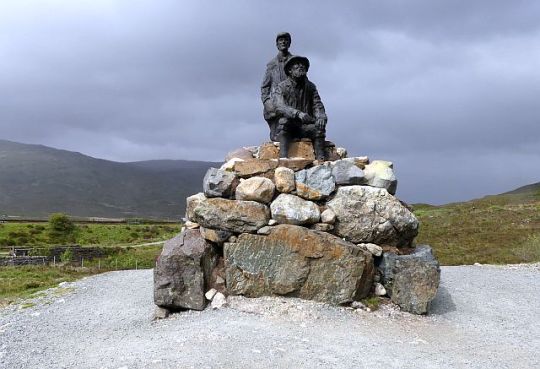
Professor John Norman Collie war ein englischer Wissenschaftler, Bergsteiger und Entdecker. Collies hat seine berufliche Laufbahn als Wissenschaftler verbracht, aber seine Berufung war Bergsteigen.
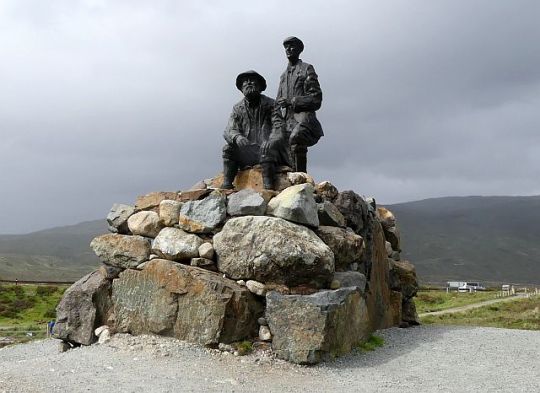
1895 begaben sich Collie, Mummery und sein Mitkletterer Geoffrey Hastings in die Himalaya-Kette, um den weltweit ersten Versuch auf einem 8.000 Meter hohen Himalaya-Gipfel, Nanga Parbat, zu unternehmen.
Sie waren ihrer Zeit um Jahre voraus, und der Berg forderte das erste seiner vielen Opfer: Mummery und zwei Gurkhas, Ragobir und Goman Singh, wurden von einer Lawine getötet und nie wieder gesehen. Die Geschichte dieser katastrophalen Expedition wird in Collies Buch erzählt. Vom Himalaya nach Skye.
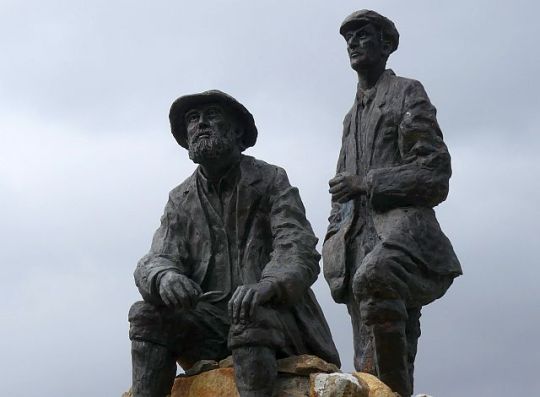
Collie ging 1929 in den Ruhestand und verbrachte danach seine Sommer in Skye. Er starb im November 1942 in Sligachan an einer Lungenentzündung, aus diesem Grund wurde hier Standpunkt für das Denkmal gewählt.
Jetzt geht es aber wirklich zurück ins schöne Cottage ...
6 notes
·
View notes
Photo



William Angus was born 28th February 1888 at Polkemmet Rows, Cappers, Armadale.
Note some sources say this brave man was born in Carlulke, others give Armadale, he certainly spent a large chunk of his life in South Lanarkshire town. where a commemorative stone was unveiled in his honour in 2015.
On leaving school Angus worked in the nearby coal mines before earning a modest living as a footballer at several clubs, 1914 he was with Wishaw Thistle when war broke out and as a member of local Carluke Territorial battalion of the Highland Light Infantry, he was mobilised immediately.
William Angus was transferred to the 8th Royal Scots, the first Territorial battalion to join the Expeditionary Force. 8th Royal Scots had suffered a great many casualties and were in urgent need of replacements. He was serving as a lance-corporal in this battalion when the following deed took place for which he was awarded the Victoria Cross.
On 12th June 1915 at Givenchy-lès-la-Bassée, France Lance-Corporal Angus voluntarily left his trench to rescue a wounded officer, fellow Carluke man Lieutenant James Martin, who was lying within a few yards of the enemy’s position and had been injured by a mine. To do this he had to travel through 64 metres in no-man’s land under heavy bomb and rifle fire, and received about 40 wounds, some of them being very serious, including the loss of his left eye, losing part of his foot and calf. His commanding officer said there had been no braver deed in the history of the army.
When asked why he had risked death to carry out such a mercy mission, he replied:
“I have to go back to Carluke. I cannot return if I left someone from Carluke to die here.”
40 wounds, can you imagine that?! Angus was awarded the VC for his bravery in August that year at Buckingham Palace, when the King commented on his 40 injuries, Angus was said to have answered “Aye, sir, but only 13 were serious.”.
Due to his injuries he was no longer fit for active duty and was transferred to Cameronians on recruitment duties and promoted to Sergeant. He was invalided out of the Army in 1917 and started a haulage business, he later became president of Carluke Rovers, where he was known simply as “The VC”., a position he held until his death. Each year of his life, he received a telegram of thanks from the family of the man he rescued.
William Angus VC died just two days after the 44th anniversary of his brave deed. His last annual telegram of thanks from the Martin family was delivered to him in hospital.
William Angus' medals on display at the National War Museum of Scotland, Edinburgh Castle.
You can read a wee bit more detail about William here http://www.vconline.org.uk/william-angus-vc/4585925970.html
12 notes
·
View notes
Text








Armadale Castle
Reblog don’t repost
13 notes
·
View notes
Text

2 Rising Lines II, artwork by Julie Brook. Armadale Castle, Isle Of Skye.
1 note
·
View note
Photo







Armadale Castle is a ruined country house in Armadale, Skye, former home of the MacDonalds. A mansion house was first built here around 1790.
Photo by Khevron 7/2008
1 note
·
View note